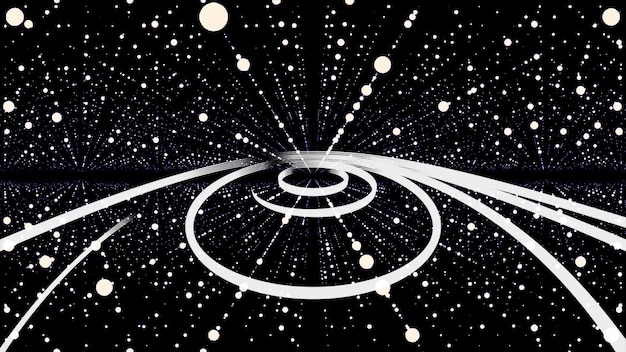US Citizens’ Guide: Participate in SETI Through Citizen Science Projects

Engaging in citizen science projects is a direct and impactful way for US citizens to actively contribute to the Search for Extraterrestrial Intelligence (SETI), leveraging collective computing power, data analysis, and observational efforts to advance our understanding of life beyond Earth.
The quest to answer one of humanity’s most profound questions – “Are we alone?” – has captivated minds for centuries. In recent decades, this pursuit has evolved from science fiction to a rigorous scientific endeavor known as the Search for Extraterrestrial Intelligence (SETI). While professional astronomers and scientists lead much of this work, the sheer volume of data involved, combined with the need for diverse perspectives, has opened unique avenues for public engagement. This article explores how US citizens can participate in the Search for Extraterrestrial Intelligence (SETI) through citizen science projects, transforming curious individuals into active contributors in humanity’s greatest cosmic treasure hunt.
Understanding the SETI Landscape and Citizen Science
The Search for Extraterrestrial Intelligence (SETI) is a broad term encompassing scientific efforts to detect intelligent life beyond Earth. These efforts primarily involve analyzing electromagnetic radiation (like radio waves or light) for signs that might indicate technological activity from another civilization. The challenges are immense: the cosmos is vast, potential signals could be faint or fleeting, and distinguishing genuine technosignatures from natural phenomena requires sophisticated tools and rigorous analysis.
This is where citizen science becomes indispensable. Citizen science projects democratize scientific research, allowing members of the general public to contribute to real-world scientific investigations. For SETI, this often translates into harnessing distributed computing power or engaging human pattern recognition skills to sift through astronomical data that would otherwise overwhelm professional researchers. The collaborative nature of these projects not only accelerates discovery but also fosters a deeper public understanding of scientific methodologies and the wonder of space exploration.
The essence of citizen science in SETI
Citizen science in SETI thrives on the principle that many eyes and many computers can achieve what a few cannot. It’s about collective effort, where passion meets purpose. Participants don’t need advanced degrees; curiosity and a willingness to learn are often the primary requirements. This model has proven highly effective in various scientific fields, from ornithology to galaxy classification, and SETI is no exception.
- Large-scale data processing: Distributed computing networks leverage idle computer power.
- Human pattern recognition: Identifying anomalies in visual or audio data that algorithms might miss.
- Educational outreach: Spreading awareness and understanding of scientific processes.
- Community building: Connecting like-minded individuals in a shared scientific pursuit.
By engaging citizens, SETI projects can process data at scales previously unimaginable, bringing the dream of discovering alien life a step closer to reality. The accessibility of these platforms means that anyone with an internet connection and a desire to contribute can become a part of this historic scientific quest.
The landscape of SETI is continuously evolving, with new technologies and methodologies emerging. Citizen science projects aim to keep pace, incorporating the latest findings and data sources to maximize the chances of discovery. This dynamic environment ensures that participant contributions remain valuable and relevant.
SETI@home: A Pioneer in Distributed Computing
SETI@home stands as perhaps the most iconic example of a citizen science project dedicated to the search for extraterrestrial intelligence. Launched by the Berkeley SETI Research Center at the University of California, Berkeley, in 1999, it revolutionized how massive astronomical data sets could be processed. The concept was elegantly simple: harness the idle computing power of millions of personal computers around the world.
Participants downloaded a small software application that ran in the background, downloading chunks of radio telescope data – primarily from the Arecibo Observatory in Puerto Rico, and later from Green Bank Observatory in West Virginia – analyzing them for potential signals that could indicate intelligent life, and then sending the results back to Berkeley. These signals included narrow-band continuous waves, pulsed signals, and triplet signals, among others, theoretically indicating artificial origins rather than natural astrophysical phenomena.
The mechanics of distributed computing for SETI
The computational demands of analyzing vast amounts of radio telescope data are immense. A single observation session can generate terabytes of information. Before distributed computing, processing this data would require supercomputers, which are expensive and limited. SETI@home bypassed this bottleneck by breaking down the huge dataset into smaller “work units.”
- Data acquisition: Radio telescopes collect signals from space.
- Data segmentation: Raw data is divided into tiny, manageable “work units.”
- Distributed processing: Each work unit is sent to a volunteer’s computer for analysis.
- Result compilation: Processed results are returned, compiled, and scrutinized for interesting patterns.
While SETI@home officially suspended new data processing in March 2020, citing a shift to back-end analysis of accumulated data, its legacy is undeniable. It demonstrated the immense power of citizen science and inspired numerous other distributed computing projects across a range of scientific disciplines. Its success highlighted the public’s eagerness to contribute to scientific discovery, even when direct results are not guaranteed.
For two decades, millions of volunteers dedicated countless hours of CPU time, contributing to an unrivaled computational effort in the history of science. Though no definitive alien signal was ever found, the project successfully processed more data than any other SETI experiment to date, narrowing down potential search areas and validating methodologies. Its pioneering spirit paved the way for other innovative approaches to citizen science in SETI.

Breakthrough Listen: A Modern Approach with Citizen Involvement
The Breakthrough Listen initiative, launched in 2015, represents the most comprehensive and well-funded SETI program to date. Supported by Russian billionaire Yuri Milner, with a commitment of $100 million over ten years, it significantly expands the scope and sensitivity of the search. Breakthrough Listen does not primarily rely on distributed computing in the same way as SETI@home, but it still incorporates citizen involvement through various platforms and data sharing initiatives.
Instead of relying on volunteer computing for all data analysis, Breakthrough Listen employs dedicated supercomputers and advanced algorithms. However, the sheer volume and complexity of the data mean that human inspection and specialized citizen science projects can still play a crucial role, particularly in identifying unusual or ambiguous signals that automated systems might overlook. These collaborations often involve specialized web-based platforms.
Engaging with Breakthrough Listen’s data
While direct CPU contribution like SETI@home is not the primary mode for Breakthrough Listen, opportunities for citizen scientists to engage with their data exist. These often involve web-based platforms that allow volunteers to examine data visualizations for potential technosignatures.
- Data visualization analysis: Online tools allow identification of patterns in spectrograms.
- Machine learning training: Assisting in classifying known interference to refine algorithms.
- Signal classification: Helping categorize various types of signals found in the data.
Projects associated with Breakthrough Listen leverage the power of human visual pattern recognition. For instance, volunteers might be asked to identify specific types of radio interference so that machine learning algorithms can be trained to filter them out more effectively, thus focusing on potentially genuine alien signals. This form of “human-in-the-loop” machine learning is critical for improving the efficacy of the automated search.
Breakthrough Listen’s robust infrastructure and broad observational capabilities across multiple telescopes (including Green Bank Telescope, Parkes Observatory, and the MeerKAT array) generate an unprecedented amount of data. This data, when made publicly available, provides a rich resource for researchers and citizen scientists alike to explore, offering new avenues for discovery beyond the initial automated analyses.
The initiative also emphasizes transparency and data sharing, making much of its acquired data publicly available. This open-science approach encourages independent analysis and the development of new search techniques, effectively inviting the global scientific community, including citizen scientists, to contribute to the grand quest for extraterrestrial intelligence.
Using Zooniverse for SETI-Related Discoveries
Zooniverse is the world’s largest and most popular platform for people-powered research, offering a wide array of citizen science projects across various domains, from astronomy and biology to history and climatic science. While not exclusively dedicated to SETI, Zooniverse hosts projects directly related to the search for technosignatures and the characterization of exoplanets, which are crucial for defining potential abodes for life.
The platform’s strength lies in its user-friendly interface, which breaks down complex scientific tasks into simple, repeatable actions that anyone can perform. For SETI, this often involves pattern recognition in visual data, where human eyes are still superior to algorithms in identifying subtle anomalies or categorizing complex features.
Examples of SETI-focused Zooniverse projects
Several projects on Zooniverse have offered direct or indirect ways for citizens to contribute to SETI, often focusing on identifying unusual patterns in astronomical data or characterizing exoplanets to determine their habitability.
- Exoplanet patrol: Cataloging and classifying exoplanets from transit data.
- Signal hunt: Identifying anomalous signal patterns in radio or optical data.
- Radio spectrum analysis: Distinguishing between human-made interference and potential alien signals.
For instance, projects might ask volunteers to look for ‘dips’ in stellar light curves that signify transiting exoplanets, helping confirm planetary candidates discovered by orbital telescopes like Kepler or TESS. Characterizing these exoplanets – determining their size, orbital period, and potential for liquid water – is vital for narrowing down the search for life.
Other Zooniverse projects might present volunteers with spectrograms – visual representations of radio signals – and ask them to classify patterns. This helps researchers distinguish between terrestrial radio interference (like Wi-Fi, cell phones, or GPS signals) and potentially artificial extraterrestrial signals. This human vetting process is invaluable for training machine learning algorithms and reducing false positives, allowing scientists to focus on genuinely intriguing anomalies.
The Zooniverse model provides immediate feedback and often features interactive tutorials, making it an engaging and educational experience. Participants can see how their individual contributions feed into larger datasets and help advance scientific understanding, fostering a sense of direct involvement in cutting-edge research.
Amateur Astronomy and SETI Contributions
While the highly specialized nature of collecting and analyzing SETI data often requires professional observatories, amateur astronomers can also contribute significantly beyond direct signal detection. Their extensive knowledge of the night sky, observational skills, and dedicated equipment can support SETI in various indirect, yet crucial, ways. This includes monitoring celestial objects that are targets for professional SETI surveys, verifying transient phenomena, or even contributing to the optical SETI (OSETI) efforts.
Amateur astronomers possess thousands of personal telescopes and cameras, along with deep practical experience. Many are highly skilled at astrophotography and can capture very faint objects or subtle changes in sky conditions. This distributed network of observational capabilities can serve as a valuable complement to large-scale professional surveys.

How amateur astronomers can contribute
Amateur astronomy contributions to SETI might not involve listening for radio signals, but they can still be incredibly impactful in the broader context of searching for life and intelligence.
- Optical SETI (OSETI) participation: Searching for brief, bright optical pulses.
- Exoplanet transit confirmation: Observing and confirming exoplanet candidates.
- Target validation: Providing contextual observations of SETI target stars or galaxies.
- Data sharing and analysis: Contributing to databases of known phenomena or anomalies.
One specific area is Optical SETI (OSETI), which looks for brief, intense flashes of light that might be artificial, such as powerful laser pulses. While professional OSETI observatories exist, amateur astronomers with fast-imaging cameras and dedicated setups can potentially search for or verify such signals from observable targets. Projects like the Optical SETI Lab at Harvard University have sometimes welcomed amateur contributions for data collection or analysis.
Moreover, amateur observations can confirm or refute exoplanet transits. When a professional team identifies a potential exoplanet from existing data, follow-up observations are often needed to confirm and characterize it. Amateur astronomers with well-calibrated equipment can sometimes contribute to these photometric campaigns, adding valuable data points and freeing up precious time on larger telescopes.
Finally, and perhaps most broadly, amateur astronomers contribute by fostering a widespread understanding and appreciation of astronomy. Their outreach efforts, whether through local astronomy clubs or online communities, inspire future generations of scientists and citizen scientists, laying the groundwork for continued public engagement in the search for life beyond Earth.
Future of Citizen Science in SETI
The landscape of SETI is constantly evolving, driven by technological advancements and new scientific hypotheses. Consequently, the role of citizen science in this grand endeavor is also poised for significant transformation. As data sets grow exponentially and artificial intelligence becomes more sophisticated, citizen scientists will likely shift from purely computational tasks to more nuanced roles involving human insight, anomaly detection, and specialized data curation.
Next-generation observatories and data collection techniques will produce unprecedented volumes of high-fidelity information, requiring equally innovative approaches to analysis. The future of citizen science in SETI will likely involve even tighter integration with machine learning, where human input helps train and validate AI algorithms designed to sift through cosmic noise for faint, elusive signals.
Emerging trends and opportunities
The future of citizen science in SETI is bright, with several exciting trends and opportunities on the horizon:
- AI-driven collaborations: Training and validating machine learning algorithms.
- Interstellar object analysis: Searching for technosignatures on objects like Oumuamua.
- New data streams: Analyzing data from novel telescopes or observing techniques.
- Enhanced visualization tools: More intuitive platforms for human pattern recognition.
One key trend is the concept of “human-in-the-loop” AI. While AI excels at processing vast amounts of data, it can struggle with truly novel or subtle patterns, or distinguishing between complex RFI (Radio Frequency Interference) and genuine technosignatures. Citizen scientists will play a vital role in reviewing AI outputs, correcting classifications, and identifying false positives or missed signals. This collaborative intelligence will make the search more efficient and robust.
The increasing interest in interstellar objects, like ‘Oumuamua and Borisov, also presents new avenues for citizen science. Analyzing data from these mysterious visitors for any signs of artificial origin could become a fascinating new frontier. Furthermore, as new types of telescopes come online (e.g., Square Kilometre Array, next-gen optical telescopes), the data they generate will open up unprecedented citizen science opportunities for analysis.
Beyond data analysis, future citizen science projects might also involve designing new algorithms, developing more user-friendly interfaces, or even participating in the early stages of mission concept development. The continued democratization of scientific tools and knowledge will empower more individuals to become not just data processors, but active co-creators in the quest for extraterrestrial intelligence.
The journey to find intelligent life beyond Earth is a long-term undertaking that requires patience, persistence, and continuous innovation. Citizen science, in its various forms, offers a powerful means to broaden participation, accelerate discovery, and inspire a global community united by cosmic curiosity.
| Key Contribution | Brief Description |
|---|---|
| 💻 Distributed Computing | Utilizing idle CPU power for large-scale data analysis (e.g., SETI@home’s legacy). |
| 👁️ Data Visualization | Human pattern recognition to identify anomalies in visual data (e.g., Zooniverse projects). |
| 🔭 Amateur Astronomy | Contributing observational data, exoplanet confirmation, or OSETI efforts. |
| 🧠 AI Collaboration | Training and validating machine learning algorithms for signal detection and classification. |
Frequently Asked Questions about SETI Citizen Science
▼
Citizen science in SETI involves ordinary individuals contributing to scientific research by analyzing data, sharing computing power, or assisting in observations. These projects leverage a large, distributed volunteer base to tackle tasks that would be too time-consuming or complex for professional scientists alone, such as sifting through vast amounts of radio telescope data.
▼
No, a formal science background is generally not required to participate in most SETI citizen science projects. These projects are designed to be accessible to the general public, often providing user-friendly interfaces, tutorials, and clear instructions. Basic computer literacy and a keen interest in the search for extraterrestrial intelligence are usually sufficient to get started and make meaningful contributions.
▼
While no definitive detection of extraterrestrial intelligence has yet occurred through citizen science, these projects significantly enhance the chances. By processing enormous datasets and identifying subtle patterns that automated systems might miss, citizen scientists exponentially expand the search space. Their contributions increase the probability of detecting a true technosignature, pushing the boundaries of what’s possible in SETI research.
▼
While the original SETI@home project is no longer processing new data, its legacy continues. Several projects on platforms like Zooniverse allow visual analysis of astronomical data relevant to SETI, such as classifying radio signals or identifying exoplanet transits. New initiatives leveraging AI and human-in-the-loop systems are also emerging, offering ongoing opportunities for participation in the broader search for technosignatures.
▼
Your contributions are immensely valuable: they help scientists process data much faster than possible with limited resources, validate automated analyses, train machine learning algorithms, and identify unique patterns that only human eyes can discern. This collective effort accelerates research, advances our understanding of the universe, and fosters global scientific literacy and engagement in critical scientific endeavors like SETI.
Conclusion
The search for extraterrestrial intelligence is a testament to humanity’s innate curiosity and our relentless pursuit of knowledge. While the vastness of space and the sheer complexity of potential signals present formidable challenges, citizen science projects provide a powerful and accessible means for anyone to contribute to this monumental endeavor. From the pioneering distributed computing of SETI@home to the sophisticated data classification tasks on platforms like Zooniverse, and the dedicated efforts of amateur astronomers, US citizens have a diverse array of opportunities to become active participants. By lending their computing power, pattern recognition skills, or observational expertise, individuals are not merely consumers of scientific discovery but vital collaborators, helping to push the boundaries of human understanding and potentially, to answer one of the most profound questions of our existence: “Are we alone?” The future of SETI engagement promises even more innovative ways for the public to join the quest, transforming every curious mind into a potential explorer of the cosmos.





